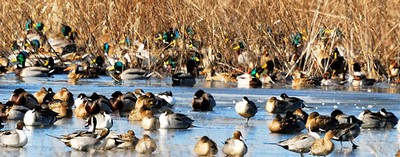Waterfowl hunting can be hit and miss depending on the weather, but food plots for ducks and geese are a great way to bring birds to your property when they are in the area. Often times, food plots can be planted to specific plants that ducks and geese consume, but other “plots” can be developed through manipulating water over native vegetation. Regardless of whether you go native or not, food plots in areas that are flooded 8 to 12 inches in depth turn into duck magnets.
When it comes to water control, a shallow dike or levee with some type of water-control structure, such as a flashboard riser, enables the water level to be manipulated over the field or food plots. Flooding of areas should be conducted gradually beginning September through November, depending upon your objectives, with full flood occurring by late November. If a crop is to planted the following year, then a drawdown should be conducted gradually and completed by late February, otherwise you will be unable to get your food plot equipment into the field.

Food plots for ducks make for amazing waterfowl hunting, but it is important to pay particular attention to Federal laws. Keep in mind that food plots for ducks cannot be manipulated like those for dove hunting. Current federal regulations allow waterfowl hunting over standing crops and harvested crops, whether they are flooded or not. Crops, however, cannot be manipulated except by standard agricultural practices used to establish, manage and harvest the crop.
Grain that is inadvertently scattered through normal harvest operations, by entering or exiting the field, or setting out decoys or retrieving birds is not considered bait. However, you should check the current years’ US Fish and Wildlife Service and state hunting regulations before heading out duck hunting. Food plots for ducks and gets can be quite effective, but just make sure you are being legal too.
One of the main considerations when developing a food source for waterfowl such as ducks and geese is deterioration of seed after flooding. Naturally occurring moist-soil plants typically persist longer than agricultural crops. For example, many moist-soil plants such as smartweeds experience only 20 to 25 percent deterioration after flooding for up to 90 days. In short, native seeds have a better “shelf life” for stocking your bird’s pantry, and making them available for harvest.
Furthermore, most agricultural crops do not contain enough protein to provide a complete diet for waterfowl. It is for these reasons that naturally occurring moist-soil plants should be encouraged either in the same flooded unit as your food plot for ducks and geese or in an adjacent flooded unit. This will help provide optimum feeding conditions for waterfowl, keeping ducks near your hunting blind all season long. For more information on food plots for ducks and geese, check out this article on food plot mixes for ducks and other waterfowl.